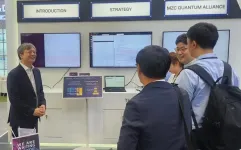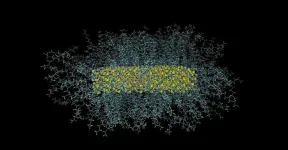(Press-News.org) Biodiversity is in crisis. Human activities are driving species extinctions at unprecedented rates, but funding for conservation remains woefully inadequate. To address this gap, the concept of a Biodiversity Credit Market (BCM) has emerged, inspired by carbon credit systems that incentivize conservation and restoration efforts.
However, while the BCM holds promise, it risks falling into the same pitfalls as its carbon counterpart—especially if it fails to implement rigorous science-backed baselines, monitoring and validation processes. In a new publication in npj Biodiversity, T. Mitchell Aide, a research associate at the Smithsonian’s National Zoo and Conservation Biology Institute (NZCBI), identifies these challenges and provides science-based solutions to ensure the BCM genuinely contributes to global biodiversity conservation.
Getting the Baseline Right
The first step for any conservation or restoration project is establishing a baseline. In theory, this baseline is essential for measuring “additionality”—how much biodiversity a project has preserved or restored beyond what would have occurred naturally.
Unfortunately, Aide argues, many carbon credit projects have manipulated baselines to exaggerate their impact. For example, projects often predict excessive future deforestation rates to amplify their achievements, leading to an over-allocation of carbon credits. This same risk exists in the biodiversity space, where defining baselines is even more complex due to the sheer variety of lifeforms and ecosystems.
Aide suggests the following solution: BCM projects should monitor control sites, both degraded and pristine, throughout the lifetime of the project to establish a dynamic and realistic baseline. Doing so allows projects to account for natural biodiversity fluctuations caused by factors like climate variability, ensuring credits are only awarded for true gains in biodiversity.
What Biodiversity Should Be Monitored?
Unlike carbon, which is a relatively simple metric, biodiversity is multifaceted. It encompasses ecosystems, species and genetic diversity—each with its own value. Measuring biodiversity isn’t as straightforward as counting trees or carbon stocks. Some BCM projects have opted to use habitat diversity, like the presence of forests or wetlands, as a proxy for biodiversity. But this can be misleading.
A forest may look intact from satellite imagery, but it could be an “empty forest” devoid of critical species due to hunting, logging or habitat fragmentation. As such, monitoring the population dynamics of species, alongside habitat measures, is essential. Tools like camera traps, acoustic sensors and environmental DNA (eDNA) are now available to track wildlife populations in non-invasive and cost-effective ways.
Monitoring should not only focus on the project site but also on nearby areas to prevent “leakage”—where conservation in one area inadvertently pushes destructive activities to another. By integrating species monitoring with habitat assessments, researchers can capture a fuller picture of biodiversity changes and ensure credits represent real conservation outcomes.
The Need for Transparent Validation
According to Aide, a critical challenge in both carbon and biodiversity markets is validation. In theory, an independent third party should verify project claims to prevent inflated outcomes. However, in practice, verification has often been compromised, with project developers selecting their own verifiers, leading to conflicts of interest.
To avoid this, Aide advocates for the BCM to establish independent regional or national verification panels. These panels would not only review the monitoring data but also oversee project approval and certification. Ideally, data from BCM projects would be publicly available through transparent platforms like blockchain, ensuring all stakeholders can verify the authenticity of biodiversity claims.
Incorporating Permanence
One major concern for the long-term success of the BCM is permanence. Biodiversity gains must be sustainable. Projects should commit to conserving habitats and species for at least 30 to 50 years. This level of commitment is critical for ensuring the biodiversity benefits last and are not simply short-term victories.
A well-designed BCM should include mechanisms to protect biodiversity beyond the lifespan of individual projects. This could involve requiring projects to create endowments to support ongoing monitoring and management long after the initial funding runs out.
Moving Forward: Getting it Right
In the last two decades, advancements in technology and artificial intelligence have revolutionized scientists' ability to monitor biodiversity. Real-time acoustic monitoring and camera traps, combined with satellite imagery and eDNA analysis, provides unprecedented insight into species dynamics and habitat health. These tools should be at the forefront of BCM project design, ensuring conservation outcomes are measurable, verifiable and transparent.
Moreover, projects need to be compared to baselines that are monitored at the same intensity as the project sites to allow for a more realistic evaluation of additionality, helping avoid the pitfalls of inflated claims that have plagued other environmental credit markets.
The time for action is now. By establishing rigorous standards, embracing cutting-edge monitoring technologies and ensuring transparency in validation, the BCM can help close the biodiversity funding gap while delivering real conservation benefits. The future of the planet’s ecosystems depends on getting it right.
END
How to make biodiversity credits work: science-based solutions for real conservation gains
2024-10-14
ELSE PRESS RELEASES FROM THIS DATE:
Qunova becomes first to achieve ‘chemical accuracy’ on commercial quantum computers with its hardware agnostic algorithm
2024-10-14
DAEJEON, South Korea (October 14, 2024) – Qunova Computing, a developer of quantum software applications designed to bring quantum computing to the chemical, pharmaceutical and industrial engineering industries, today announces the results from a series of recent tests performed on three different NISQ era quantum computers, each with a different qubit count. In each demonstration, Qunova’s algorithm was able to produce results with accuracy below the threshold of 1.6 millihartrees required for real-world quantum chemistry applications, a level known as ‘chemical ...
Scientists have successfully bred corals to improve their heat tolerance
2024-10-14
Scientists have successfully bred corals to improve their heat tolerance
A new study has shown that selective breeding can lead to a modest rise in coral heat tolerance.
Led by experts at Newcastle University’s Coralassist Lab, the study documents the world’s first effort to selectively breed adult corals for enhanced heat tolerance, i.e. the ability of adult corals to survive intense marine heatwaves. The breeding effort was a success, showing that it is possible to improve the heat tolerance of adult coral offspring, even in a single generation.
However, the improvement was modest in comparison ...
Adaptability of trees persists after millions of years of climate change
2024-10-14
Seven of the most common forest trees in Europe have been shown to be able to shelter their genetic diversity from major shifts in environmental conditions. This is despite their ranges having shrunk and the number of trees having fallen sharply during ice age cycles. These are the findings of a study by a European consortium including Uppsala University, published in Nature Communications.
“From a biodiversity perspective, this is very positive because these trees are keystone species on which many other species depend,” says Pascal Milesi, Associate Professor of Plant Ecology and Evolution at Uppsala University and first author of the study.
The researchers aimed to investigate ...
Protein involved in balancing DNA replication and restarting found
2024-10-14
A protein that is involved in determining which enzymes cut or unwind DNA during the replication process has been identified in a new study.
In a new paper published in Nature Communications, an international team of researchers have found that the protein USP50 supports the DNA replication process by helping to decide the proper use of nucleases or helicases. These enzymes are implemented during the DNA replication process to promote ongoing replication and where the copying machinery runs into problems ...
How liberals and conservatives can have better conversations, according to a psychologist
2024-10-14
Bridging Our Political Divide collects the insights of a psychologist who offers antidotes to the unproductive arguments that now dominate our political culture and ways to find common ground.
New York, U.S./Oxford, UK, October 14, 2024 – As the 2024 US Presidential Election in November inches closer, the partisan divide in American society has never felt more apparent – or pervasive.
From workplace chatter to heated discussions at family gatherings, many Americans may have asked themselves, ‘How can I make this ...
Survey finds 25% of adults suspect they have undiagnosed ADHD
2024-10-14
COLUMBUS, Ohio – Attention deficit/hyperactivity disorder – also known as ADHD – is typically thought of as a childhood condition. But more adults are realizing that their struggles with attention, focus and restlessness could in fact be undiagnosed ADHD, thanks in large part to trending social media videos racking up millions of views.
A new national survey of 1,000 American adults commissioned by The Ohio State University Wexner Medical Center and College of Medicine finds that 25% of adults now suspect they may have undiagnosed ADHD. But what worries mental health experts is that only 13% of survey respondents have shared their suspicions with their doctor.
That’s ...
Let there be light: Bright future for solar panels, TV screens and more
2024-10-14
From brighter TV screens to better medical diagnostics and more efficient solar panels, new Curtin-led research has discovered how to make more molecules stick to the surface of tiny nanocrystals, in a breakthrough that could lead to improvements in everyday technology.
Lead author Associate Professor Guohua Jia from Curtin’s School of Molecular and Life Sciences, said the study investigated how the shape of zinc sulfide nanocrystals affected how well molecules, known as ligands, stick to their surface.
“Ligands, play an important role in controlling the behaviour and performance ...
Innovative nanoparticle therapy targets fat absorption to combat obesity
2024-10-13
(Monday 14 October 2024, Vienna, Austria) Researchers have unveiled a novel approach to tackle obesity by targeting fat absorption in the small intestine. The cutting-edge nanoparticle system, engineered to deliver therapeutic molecules directly to the digestive tract, has shown significant potential to prevent diet-induced obesity.1,2
Presented today at UEG Week 2024, the study focuses on an enzyme called Sterol O-acyltransferase 2 (SOAT2), which plays a critical role in fat absorpsion in the small intestine.3,4 By inhibiting this enzyme in the small intestine, the study offers a promising therapeutic approach to reduce fat absorption ...
Novel procedure combined with semaglutide may eliminate insulin dependency in type 2 diabetes
2024-10-13
(Monday 14 October 2024, Vienna, Austria) Groundbreaking research presented today at UEG Week 2024 reveals a promising new treatment strategy for type 2 diabetes (T2D) that could significantly reduce or even eliminate the need for insulin therapy.1
This innovative approach, which combines a novel procedure known as ReCET (Re-Cellularization via Electroporation Therapy) with semaglutide, resulted in the elimination of insulin therapy for 86% of patients.
Globally, T2D affects 422 million people, with obesity recognised as a significant ...
Three key signs of major trauma could speed up treatment of severely injured children brought to emergency departments by carers not ambulances
2024-10-13
Copenhagen, Denmark: Severely injured children who are brought to an emergency medical department by their parents or carers are often not seen as quickly as those who arrive at hospital via ambulance, according to findings presented at the European Emergency Medicine Congress today (Monday). [1]
The study’s researchers identified three key trauma features that should prompt doctors to review these patients immediately and potentially prioritise their treatment: boggy swelling to the head, abdominal bruising, and thigh swelling or deformity.
The study was carried out in an inner-city ...




